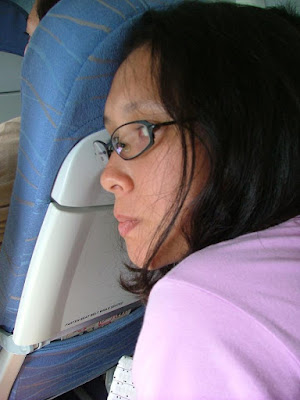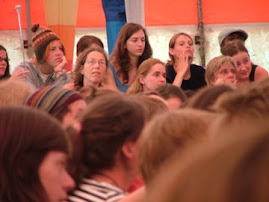[This piece was developed from Patrick's notes for SARANGGANI SCAPE Magazine.]

It is mid-afternoon and a little girl of about seven years old is washing clothes at a common faucet where the rest of the community gets its water. She is unaware that my friend and I are taking pictures of her. When the little girl looks up, my friend tries to coax her out of the shyness and bewilderment drawn on her face. Too late. The little girl has turned serious, suddenly very self-conscious. Some adults milling about start to tease her. Candid camera moment lost I think. But just as I am about to give up, the little girl flashes a splendid smile for the camera.
Two years ago, the community here used to draw water with hand pumps installed a short distance from a creek bisecting the neighborhood. The water from the pumps sometimes smelled funny or was cloudy. Waterborne diseases occurred during rainy days. This was the problem of the nearly 200 families who have built their small bamboo houses near the creek that runs through the splendid mountains rising just a couple of meters behind. Living in paradise yet having no clean drinking water.
Around the world, roughly two billion people face the same predicament. As a result, the United Nations has listed access to clean water as one of the 10 Millennium Development Goals. What truly inspires me about the residents of Sapu Padidu, in the municipality of Malapatan, is that they have achieved this goal on their own initiative. Today, I and my friends are visiting the community to listen to the story of their quest for clean water.
We follow Kagawad Eduardo Velasco, our guide, past a makeshift basketball court and three sari-sari stores where some are playing billiards and singing karaoke. We then cross a stream where two naked children are playing. It is uphill from there as we hike up a ridge with on our left, the creek, and on our right, clusters of nipa huts. A couple of meters before the creek disappears into the mountain, a small hill blocks our path. On it stands the water reservoir elevated by four posts. It is, I estimate, about four meters wide and four meters high.
Kagawad Eduardo recounts that building the water reservoir entailed the patient but persistent collection of money from various sources. He traveled back and forth to follow up the water project with national government agencies and non-government organizations, and rallied the support of residents and local government officials.
Unmindful of the heat of the sun, Kagawad Eduardo stands beside the concrete container on the hill and enthusiastically tells us about all the government departments that helped finance the water project. He flashes his big smile and says that the provincial government gave funds for the construction of the water reservoir. The Department of Public Works and Highways (DPWH) also gave funds to construct a much bigger water reservoir at the spring source. On top of that, the provincial government and DPWH shared funds for black plastic pipes to bring water to the community.
I further learn that the local government of Malapatan contributed the use of the municipal dump trucks to transport the materials up the mountain. The problem was how to get to the spring at the bottom of a ravine. This problem was solved by paying men from the barangay to carry sacks of cement through a steep mountain trail covered with thick vegetation. Once the huge concrete container was in place at the spring source, the men carried pipes measuring 20 feet and connected them one by one over a distance of four kilometers along the mountain slopes until the pipes reached the water reservoir near the community. From the main barangay area, the pipes cover an area of about 1.5 kilometers and end at the provincial highway.
The pipes wind through the grass over potholes, rocks, and pools of water, like a big fat snake connecting the communal faucets along the road. Wells, which were once the main source of water, now lie abandoned and forgotten as people prefer doing their laundry and bathing in the strong stream gushing out of the pipes. But because the pipes are not far-reaching enough, the people living across the highway have to walk to get their water from the other side where the pipes are. This inconvenience has been resolved by some who engage in collecting, distributing, and selling the water by the gallon for a handful of pesos.
Needless to say, Kagawad Eduardo and other barangay officials are moving heaven and earth, so to speak, to find more money while saving the remaining barangay funds to add to the funds given by the municipality of Malapatan. When there is enough money, the pipes will be extended across the highway and be connected to the tank nearby which has already been completed with the help of World Vision International. The plan is to connect the tank to more pipes and disperse them around the area in order to meet the needs of the growing community.
Though more money needs to be collected to install more pipes, life has become so much easier because of the pipes already in place. The success story of Sapu Padidu lies in the efforts put into networking, lobbying, proper accounting of funds, and using it only for what it is intended. I predict that those disillusioned with government will find the strong initiative and integrity of the leaders of Sapu Padidu heartwarming and worth emulating a thousand times over.
Two years ago, the community here used to draw water with hand pumps installed a short distance from a creek bisecting the neighborhood. The water from the pumps sometimes smelled funny or was cloudy. Waterborne diseases occurred during rainy days. This was the problem of the nearly 200 families who have built their small bamboo houses near the creek that runs through the splendid mountains rising just a couple of meters behind. Living in paradise yet having no clean drinking water.
Around the world, roughly two billion people face the same predicament. As a result, the United Nations has listed access to clean water as one of the 10 Millennium Development Goals. What truly inspires me about the residents of Sapu Padidu, in the municipality of Malapatan, is that they have achieved this goal on their own initiative. Today, I and my friends are visiting the community to listen to the story of their quest for clean water.
We follow Kagawad Eduardo Velasco, our guide, past a makeshift basketball court and three sari-sari stores where some are playing billiards and singing karaoke. We then cross a stream where two naked children are playing. It is uphill from there as we hike up a ridge with on our left, the creek, and on our right, clusters of nipa huts. A couple of meters before the creek disappears into the mountain, a small hill blocks our path. On it stands the water reservoir elevated by four posts. It is, I estimate, about four meters wide and four meters high.
Kagawad Eduardo recounts that building the water reservoir entailed the patient but persistent collection of money from various sources. He traveled back and forth to follow up the water project with national government agencies and non-government organizations, and rallied the support of residents and local government officials.
Unmindful of the heat of the sun, Kagawad Eduardo stands beside the concrete container on the hill and enthusiastically tells us about all the government departments that helped finance the water project. He flashes his big smile and says that the provincial government gave funds for the construction of the water reservoir. The Department of Public Works and Highways (DPWH) also gave funds to construct a much bigger water reservoir at the spring source. On top of that, the provincial government and DPWH shared funds for black plastic pipes to bring water to the community.
I further learn that the local government of Malapatan contributed the use of the municipal dump trucks to transport the materials up the mountain. The problem was how to get to the spring at the bottom of a ravine. This problem was solved by paying men from the barangay to carry sacks of cement through a steep mountain trail covered with thick vegetation. Once the huge concrete container was in place at the spring source, the men carried pipes measuring 20 feet and connected them one by one over a distance of four kilometers along the mountain slopes until the pipes reached the water reservoir near the community. From the main barangay area, the pipes cover an area of about 1.5 kilometers and end at the provincial highway.
The pipes wind through the grass over potholes, rocks, and pools of water, like a big fat snake connecting the communal faucets along the road. Wells, which were once the main source of water, now lie abandoned and forgotten as people prefer doing their laundry and bathing in the strong stream gushing out of the pipes. But because the pipes are not far-reaching enough, the people living across the highway have to walk to get their water from the other side where the pipes are. This inconvenience has been resolved by some who engage in collecting, distributing, and selling the water by the gallon for a handful of pesos.
Needless to say, Kagawad Eduardo and other barangay officials are moving heaven and earth, so to speak, to find more money while saving the remaining barangay funds to add to the funds given by the municipality of Malapatan. When there is enough money, the pipes will be extended across the highway and be connected to the tank nearby which has already been completed with the help of World Vision International. The plan is to connect the tank to more pipes and disperse them around the area in order to meet the needs of the growing community.
Though more money needs to be collected to install more pipes, life has become so much easier because of the pipes already in place. The success story of Sapu Padidu lies in the efforts put into networking, lobbying, proper accounting of funds, and using it only for what it is intended. I predict that those disillusioned with government will find the strong initiative and integrity of the leaders of Sapu Padidu heartwarming and worth emulating a thousand times over.

























3 comments:
I love the picture. :) Spur-of-the moment beauty.
Hi Bam,
Yes, a beauty indeed. I sure cannot remember if i ever did any clothes washing at that age!
Congratz Maya! Very good decision!Will follow it:)
Post a Comment